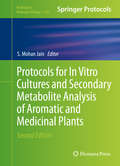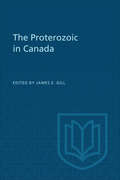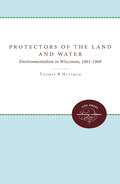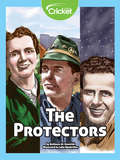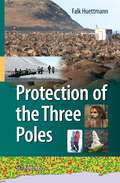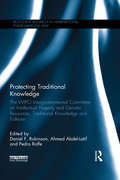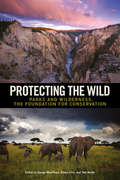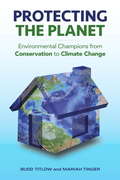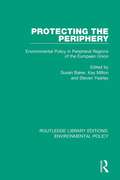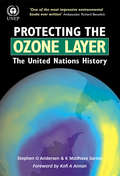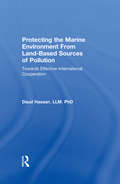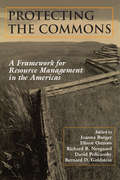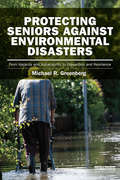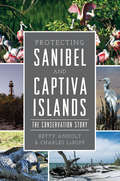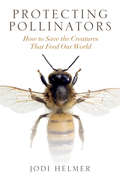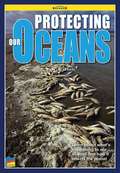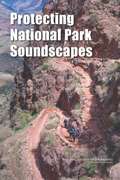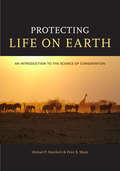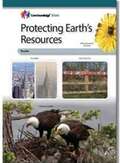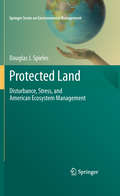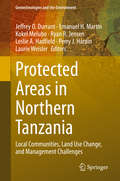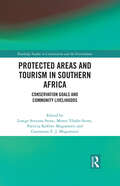- Table View
- List View
Protocols for In Vitro Cultures and Secondary Metabolite Analysis of Aromatic and Medicinal Plants, Second Edition
by S. Mohan JainThis volume provides a detailed step-by-step description of protocols for the establishment of in vitro cultures of important medicinal plants, their mass multiplication in controlled environment, and step-wise secondary metabolite analysis. Many of these protocols also provide a basis for in vitro germplasm conservation or cryopreservation of medicinal plant species. Written for the Methods in Molecular Biology series, chapters include introductions to their respective topics, lists of the necessary materials and reagents, step-by-step, readily reproducible laboratory protocols, and tips on troubleshooting and avoiding known pitfalls. Authoritative and practical, Protocols for In Vitro Cultures and Secondary Metabolite Analysis of Aromatic and Medicinal Plants, Second Edition aims to ensure successful results in the further study of this vital field.
Protest-Aktivist*innen der Umweltschutz-Bewegung im Netz und auf der Straße: Voraussetzungen und Motive für Partizipation (Medien der Kooperation – Media of Cooperation)
by Lisa VilliothDieses Open-Access-Buch untersucht mit Fokus auf einzelne Bürger*innen fallspezifisch und empirisch den Handlungs- und Wirkungszusammenhang von Straßenprotest und Online-Aktivismus im Bereich der Umweltschutz-Bewegung. Eine ganze Bandbreite von Online- und Offline-Protestpraktiken erlaubt es Bürger*innen heutzutage, sich in politische Prozesse einzumischen, Öffentlichkeit für bestimmte Themen zu erzeugen und Politiker*innen und Unternehmen unter Druck zu setzen. Online ist hierbei jedoch nicht zwangsläufig Ersatz für Offline. In vielen Situationen von Protestpartizipation ergänzen sich Elemente beider Sphären. Warum entschließen sich Bürger*innen, ganz spezifischen Praktiken – online wie offline – nachzugehen und anderen Praktiken nicht? Welche Vor- und Nachteile benennen sie für die einzelnen ihnen zur Verfügung stehenden Formate? Die Arbeit steht im Schnittfeld unterschiedlicher politikwissenschaftlicher Forschungsfelder wie der Protestforschung, der politischen Partizipationsforschung und der Forschung rund um das Thema Digitalisierung. Basierend auf 18 Leitfaden-Interviews und einer ausführlichen Analyse werden sechs Typen von Protest-Aktivist*innen gebildet.
The Proterozoic in Canada (The Royal Society of Canada Special Publications #2)
by James E. GillProterozoic time produced much of great interest to geologists, and was of tremendous economic import to the people of Canada and the United States. Most of the iron deposits of the Lake Superior district, the Michigan copper deposits, the enormously important Sudbury nickel-copper-platinum deposits, the spectacular silver deposits of the Cobalt district, and all of the important uranium ores in the Shield area are considered to have formed during this period in geological time. Proterozoic rock groups include those Precambrian rocks which are least deformed and metamorphosed. Because of their important economic deposits, they have been examined in great detail in certain localities. The results of such examination, and of others which were for reconnaissance only, are summarized in this volume of the Royal Society of Canada. Suggestions are made for revision of previous interpretations of Precambrian history, and the terminology which grew out of them. Three papers deal with problems arising from the current use of the term Proterozoic, and with possible changes in its use to bring it more into accord with the facts. Contributors to this volume are: E.M. Abraham, Robert Bergeron, R.G. Blackadar, I.C. Brown, G.H. Charleswood, J.F. Davies, K.E. Eade, W.F. Fahrig, R.M. Farquhar, James E. Gill, H.C. Gunning, J.M. Harrison, D.F. Hewitt, W.W. Moorhouse, J.E. Reesor, S.M. Roscoe, R.D. Russell, James E. Thomson, Robert Thomson, L.J. Weeks, Alice E. Wilson, J.T. Wilson, G.M. Wright.
Protectors of the Land and Water: Environmentalism in Wisconsin, 1961-1968
by Thomas R. HuffmanSince the beginning of the twentieth century, Wisconsin citizens have promoted innovative environmental programs. During the 1960s Wisconsin was again at the forefront of the movement advancing mainstream political environmentalism. Thomas Huffman traces the rise of environmentalism in the Badger State during these key years, when the people of Wisconsin instituted policies in such areas as outdoor recreation and resource planning, water pollution control, the preservation of wild rivers, and centralized environmental management. Huffman focuses especially on the influence of Senator Gaylord Nelson, a Democrat and founder of Earth Day, and Governor Warren Knowles, a Republican. He shows that their efforts--and the efforts of their followers in citizen groups, the business and university communities, and the state government--clearly indicate that the origins of environmentalism cannot be placed along a left-right political spectrum. Rather, the movement evolved from an interweaving of liberal and conservative ideologies and from important traditions and precedents within the state's environmental culture. What happened in Wisconsin is particularly significant, Huffman points out, because of the effect of that state's example on other states and the federal government.Originally published in 1994. A UNC Press Enduring Edition -- UNC Press Enduring Editions use the latest in digital technology to make available again books from our distinguished backlist that were previously out of print. These editions are published unaltered from the original, and are presented in affordable paperback formats, bringing readers both historical and cultural value.
The Protectors
by Kathiann M. KowalskiIt takes commitment to overcome interests that stand in the way of protecting the environment. Meet three people who weren't afraid to speak up to protect natural areas—and us.
Protection of the Three Poles
by Falk HuettmannThe Arctic, the Antarctic, and the Hindu Kush-Himalayas form a trio of terrains sometimes called "the three poles". Mainly composed of rock, snow, and ice, these precious regions, which are home to many unique species such as the polar bear, the emperor penguin, and the snow leopard, contain the primary water resource of this planet and directly shape our climate. This book presents a first-ever global assessment and progressive review of the three poles and demonstrates the urgent need for their protection. Sins of the past have irrevocably harmed and threatened many of the unique qualities of these regions, and the future looks bleak with the global population forecast to reach 9 billion by 2060, and with climate change on the rise. Presented here is a wide-reaching and coherent overview of the three poles' biodiversity, habitats, and ongoing destruction. Failed protection and social targets set by the United Nations and other bodies are exposed while economic growth, unconstrained or inappropriate development, and urban sprawl are promoted unabated. Polar regions play a major role in the global agenda as they are rich in oil and other resources, marking them for contamination, overfishing, and further degradation. Tourism in the Antarctic has benefited from enlightened self-regulation, but there are signs that this is changing, too. The chapters of this book are written by experts in their fields, and their evidence leaves no doubt that we already live beyond our carrying capacity on a finite but decaying space. A global protection role model and several outlook scenarios are proposed to help set in motion polar protection priorities that are actually valid. Humanity has demonstrated through international treaties such as the Antarctic Treaty and the Madrid Protocol that we can put the interests of the planet as a whole first. This must become the norm, not the exception.
Protection of Global Biodiversity: Converging Strategies
by Jeffrey Mcneely Lakshman D. GuruswamyThe rate of extinction of biological species is greater today than at any time in the last 65 million years. Some predict that if this rate continues, two-thirds of all living species will disappear during the next century. Because reaching consensus on specific courses of action involves complex issues, any adequate response to this impending crisis must include coverage of many areas of inquiry and understanding. Protection of Global Biodiversity features essays by distinguished international experts who communicate with each other across disciplinary boundaries to address the challenge of formulating policies to protect biodiversity.Although the global community has recently adopted a Convention of Biological Diversity, the agreement sets forth only abstract goals. Contributors to this volume advance the Convention's initial steps by providing workable solutions that can be implemented regionally, nationally, and locally. The contributors--including natural, social, and political scientists; economists; lawyers; and environmentalists; and decisionmakers in business, agriculture, and government--have united to create a common discourse and to evaluate and propose strategies for halting this alarming loss of biodiversity. In recognizing the diverse aspects of this task--scientific, economic, institutional, moral, and legal--this book presents a new picture of emerging action.Contributors. S. James Anaya, Gregory Benford, Graciela Chichilnisky, S. Todd Crider, Yvonne Cripps, Robert T. Fraley, Anil K. Gupta, Lakshman D. Guruswamy, G. M. Heal, Brent Hendricks, Robert B. Horsch, Laura L. Jackson, Annie Lovejoy, Ariel E. Lugo, Jeffrey A. McNeely, Brian G. Norton, Elinor Ostrom, Peter H. Raven, John W. Reid, Walter V. Reid, Mark Sagoff, Roger A. Sedgo, R. David Simpson, Ana Sittenfeld, Christopher D. Stone, Gary H. Toenniessen
Protecting Traditional Knowledge: The WIPO Intergovernmental Committee on Intellectual Property and Genetic Resources, Traditional Knowledge and Folklore (Routledge Research in International Environmental Law)
by Daniel F. Robinson Ahmed Abdel-Latif Pedro RoffeThis is the first comprehensive review of the Intergovernmental Committee (IGC) of the World Intellectual Property Organization (WIPO) established in 2000. It provides an in-depth consideration of the key thematic areas within WIPO discussions – genetic resources (GRs), traditional knowledge (TK) and traditional cultural expressions (TCEs) through the perspectives of a broad range of experts and stakeholders, including indigenous peoples and local communities. It also looks at how these areas have been treated in a number of forums and settings (including national systems and experiences, and also in trade agreements) and the interface with WIPO discussions. Furthermore, the book analyses the process and the negotiation dynamics since the IGC received a mandate from WIPO members, in 2009, to undertake formal text-based negotiations towards legal instruments for the protection of GR, TK and TCEs. While there has been some progress in these negotiations, important disagreements persist. If these are to be resolved, the adoption of these legal instruments would be a significant development towards resolving key gaps in the modern intellectual property system. In this regard, the book considers the future of the IGC and suggests options which could contribute towards achieving a consensual outcome.
Protecting the Wild: Parks and Wilderness, the Foundation for Conservation
by Tom Butler George Wuerthner Eileen CristProtected natural areas have historically been the primary tool of conservationists to conserve land and wildlife. These parks and reserves are set apart to forever remain in contrast to those places where human activities, technologies, and developments prevail. But even as the biodiversity crisis accelerates, a growing number of voices are suggesting that protected areas are passé. Conservation, they argue, should instead focus on lands managed for human use--working landscapes--and abandon the goal of preventing human-caused extinctions in favor of maintaining ecosystem services to support people. If such arguments take hold, we risk losing support for the unique qualities and values of wild, undeveloped nature. Protecting the Wild offers a spirited argument for the robust protection of the natural world. In it, experts from five continents reaffirm that parks, wilderness areas, and other reserves are an indispensable--albeit insufficient--means to sustain species, subspecies, key habitats, ecological processes, and evolutionary potential. Using case studies from around the globe, they present evidence that terrestrial and marine protected areas are crucial for biodiversity and human well-being alike, vital to countering anthropogenic extinctions and climate change. A companion volume to Keeping the Wild: Against the Domestication of Earth, Protecting the Wild provides a necessary addition to the conversation about the future of conservation in the so-called Anthropocene, one that will be useful for academics, policymakers, and conservation practitioners at all levels, from local land trusts to international NGOs.
Protecting the Wild
by George Wuerthner Eileen Crist Tom ButlerProtected natural areas have historically been the primary tool of conservationists to conserve land and wildlife. These parks and reserves are set apart to forever remain in contrast to those places where human activities, technologies, and developments prevail. But even as the biodiversity crisis accelerates, a growing number of voices are suggesting that protected areas are passé. Conservation, they argue, should instead focus on lands managed for human use--working landscapes--and abandon the goal of preventing human-caused extinctions in favor of maintaining ecosystem services to support people. If such arguments take hold, we risk losing support for the unique qualities and values of wild, undeveloped nature. Protecting the Wild offers a spirited argument for the robust protection of the natural world. In it, experts from five continents reaffirm that parks, wilderness areas, and other reserves are an indispensable--albeit insufficient--means to sustain species, subspecies, key habitats, ecological processes, and evolutionary potential. Using case studies from around the globe, they present evidence that terrestrial and marine protected areas are crucial for biodiversity and human well-being alike, vital to countering anthropogenic extinctions and climate change. A companion volume to Keeping the Wild: Against the Domestication of Earth, Protecting the Wild provides a necessary addition to the conversation about the future of conservation in the so-called Anthropocene, one that will be useful for academics, policymakers, and conservation practitioners at all levels, from local land trusts to international NGOs.
Protecting the Planet: Environmental Champions from Conservation to Climate Change
by Budd Titlow Mariah TingerClimate change is often associated with predictions of dire calamities. But in the past, heroic individuals have stepped forward to meet even the most ominous ecological challenges. This book tells an inspirational story--a story both of pioneering environmentalists who raised our collective consciousness regarding nature's value and heroes of today who are working to secure a sustainable future.The authors begin with the mounting evidence for climate change as seen in rising carbon dioxide levels, higher global temperatures, melting ice sheets, and sea level rise. They then review the history of the US environmental movement, focusing on the key people who changed our understanding of the human impact on our natural surroundings. These include John James Audubon, Henry David Thoreau, John Burroughs, Theodore Roosevelt, John Muir, Bob Marshall, Roger Tory Peterson, Aldo Leopold, Rachel Carson, David Brower, Barry Commoner, Donella Meadows, and many more. Turning to the present, the authors recount the activities of people currently pursuing remedies for climate change--scientists, researchers, activists, artists, and celebrities. Much of this information is based on recent personal interviews.They conclude with a set of actionable strategies, demonstrating that there are good reasons to hope that we can achieve a sustainable lifestyle, protect our planet as our home, and ensure the future for our children.From the Hardcover edition.
Protecting the Periphery: Environmental Policy in Peripheral Regions of the European Union (Routledge Library Editions: Environmental Policy #1)
by Susan Baker Kay Milton Steven YearleyFirst published in 1994. ln Protecting the Periphery the editors present a series of papers revealing the impact of EU policies on environmental quality in regions at the edge of the European Union and in those lying just outside it. In many cases these regions contain habitats and landscapes of international importance; they have also often escaped some of the environmental damage caused by industrialization. But, as the papers' reveal, attempts by the EU to safeguard these environmental benefits are often contradicted by the EU’s own development policies, bringing air pollution from new roads, contamination from new industries, and leading to habitat destruction from modern agricultural practices and increases in tourism. As the Union pushes for the deepening of the integration process, including completing the internal market, the pressures on the periphery's environment are increasing. Furthermore, the efforts of the periphery to catch-up economically with the developed core can often heighten the tension between economic considerations on the one hand and the need for environmental protection on the other. The studies in this book examine the ambivalent responses to EU environmental policy among policy-makers and environmentalists in the periphery. Both the willingness as well as the capacity of the periphery to protect its environmental heritage are explored. In particular, the administrative capacity, institutional arrangements, political culture as well as economic development needs are taken into account in an examination of the nature of the periphery’s response to and implementation of Union environmental policy. The book will appeal to policy-makers and academics in the countries of the European periphery and to analysts of European policy-making everywhere, especially those concerned with environmental policy and politics.
Protecting the Ozone Layer: The United Nations History
by Stephen O Andersen K Madhava SarmaIn the 1970s the world became aware of a huge danger: the destruction of the stratospheric ozone layer by CFCs escaping into the atmosphere, and the damage this could do to human health and the food chain. So great was the threat that by 1987 the UN had succeeded in coordinating an international treaty to phase out emissions; which, over the following 15 years has been implemented. It has been hailed as an outstanding success. It needed the participation of all the parties: governments, industry, scientists, campaigners, NGOs and the media, and is a model for future treaties. This volume provides the authoritative and comprehensive history of the whole process from the earliest warning signs to the present. It is an invaluable record for all those involved and a necessary reference for future negotiations to a wide range of scholars, students and professionals.
Protecting the Marine Environment From Land-Based Sources of Pollution: Towards Effective International Cooperation
by Daud HassanGlobal findings estimate that 80 per cent of marine pollution originates from land-based sources and is trans-boundary in nature. These problems persist in spite of a number of legal and policy initiatives taken to protect the marine environment. This volume explores the applications and shortcomings of current international regimes in addressing these issues. The book identifies the sources and effects of land-based marine pollution and analyzes the problems of controlling them. Management principles, policy and regulation are examined at both regional and international level. The author discusses the strengths and weaknesses of existing regimes and advances a more effective international legal framework. The text provides a valuable insight into an important area of international environmental law. It will be of interest to researchers and policy-makers working in this area.
Protecting the Commons: A Framework For Resource Management In The Americas
by Elinor Ostrom Joanna Burger David Policansky Bernard D. Goldstein Richard NorgaardCommons -- lands, waters, and resources that are not legally owned and controlled by a single private entity, such as ocean and coastal areas, the atmosphere, public lands, freshwater aquifers, and migratory species -- are an increasingly contentious issue in resource management and international affairs.Protecting the Commons provides an important analytical framework for understanding commons issues and for designing policies to deal with them. The product of a symposium convened by the Scientific Committee on Problems of the Environment (SCOPE) to mark the 30th anniversary of Garrett Hardin's seminal essay "The Tragedy of the Commons" the book brings together leading scholars and researchers on commons issues to offer both conceptual background and analysis of the evolving scientific understanding on commons resources. The book: gives a concise update on commons use and scholarship offers eleven case studies of commons, examined through the lens provided by leading commons theorist Elinor Ostrom provides a review of tools such as Geographic Information Systems that are useful for decision-making examines environmental justice issues relevant to commons .Contributors include Alpina Begossi, William Blomquist, Joanna Burger, Tim Clark, Clark Gibson, Michael Gelobter, Michael Gochfeld, Bonnie McCay, Pamela Matson, Richard Norgaard, Elinor Ostrom, David Policansky, Jeffrey Richey, Jose Sarukhan, and Edella Schlager.Protecting the Commons represents a landmark study of commons issues that offers analysis and background from economic, legal, social, political, geological, and biological perspectives. It will be essential reading for anyone concerned with commons and commons resources, including students and scholars of environmental policy and economics, public health, international affairs, and related fields.
Protecting Seniors Against Environmental Disasters: From Hazards and Vulnerability to Prevention and Resilience (Earthscan Risk in Society)
by Michael R GreenbergThe baby boom generation were born between 1946 and 1964 and are the largest population cohort in US history. They should number about 90 million by mid-century, more than doubling their current size. The massive increase in seniors and relative decline of those of working age in the US is mirrored in almost all the world’s most populous countries. This book connects the dots between the US baby boom generation and the marked increase in natural and human-caused disasters. It evaluates options available to seniors, their aids, for and not-for and for-profit organizations and government to reduce vulnerability to hazard events. These include coordinated planning, risk assessment, regulations and guidelines, education, and other risk management efforts. Using interviews with experts, cases studies, especially of Superstorm Sandy, and literature, it culls best practice and identify major gaps. It is original and successful in making the connection between the growing group of vulnerable US seniors, environmental events, and risk management practices in order to isolate the most effective lessons learned.
Protecting Sanibel and Captiva Islands: The Conservation Story (Natural History)
by Betty Anholt Charles LeBuffThe vibrant Sanibel and Captiva Islands are ecological marvels compared to Florida's many overbuilt barrier islands. Development began with the construction of the Sanibel Island Lighthouse in 1884, when only the lighthouse keeper and assistant and their families lived on the island. Noted conservationist Jay N. "Ding" Darling led the charge in preserving the islands' wildlife and natural beauty from the greed of real estate speculators and land developers in the 1930s. Former presidents like Harry Truman and cabinet-level executives worked alongside Sanibel and Captiva residents, setting up preserves and wildlife refuges to guard the integrity of the islands' unique natural blessings, abundant wildlife and aquatic stores. Charles LeBuff and Betty Anholt review the evolution of the islands' conservation ethic and how it perseveres even today.
Protecting Pollinators: How to Save the Creatures that Feed Our World
by Jodi HelmerWe should thank a pollinator at every meal. These diminutive creatures fertilize a third of the crops we eat. Yet half of the 200,000 species of pollinators are threatened. Birds, bats, insects, and many other pollinators are disappearing, putting our entire food supply in jeopardy. In North America and Europe, bee populations have already plummeted by more than a third and the population of butterflies has declined 31 percent.Protecting Pollinators explores why the statistics have become so dire and how they can be reversed. Jodi Helmer breaks down the latest science on environmental threats and takes readers inside the most promising conservation initiatives. Efforts include famers reducing pesticides, cities creating butterfly highways, volunteers ripping up invasive plants, gardeners planting native flowers, and citizen scientists monitoring migration. Along with inspiring stories of revival and lessons from failed projects, readers will find practical tips to get involved. They will also be reminded of the magic of pollinators—not only the iconic monarch and dainty hummingbird, but the drab hawk moth and homely bats that are just as essential. Without pollinators, the world would be a duller, blander place. Helmer shows how we can make sure they are always fluttering, soaring, and buzzing around us.
Protecting Our Oceans
by Jeanette LeardiLearn about the marine life that lives in the world's oceans and how people can protect these habitats by keeping the ocean clean.
Protecting National Park Soundscapes
by Proctor ReidAmerica's national parks provide a wealth of experiences to millions of people every year. What visitors see--landscapes, wildlife, cultural activities--often lingers in memory for life. And what they hear adds a dimension that sight alone cannot provide. Natural sounds can dramatically enhance visitors' experience of many aspects of park environments. In some settings, such as the expanses of Yellowstone National Park, they can even be the best way to enjoy wildlife, because animals can be heard at much greater distances than they can be seen. Sounds can also be a natural complement to natural scenes, whether the rush of water over a rocky streambed or a ranger's explanation of a park's history. In other settings, such as the New Orleans Jazz National Historical Park, sounds are the main reason for visiting a park. The acoustical environment is also important to the well-being of the parks themselves. Many species of wildlife depend on their hearing to find prey or avoid predators. If they cannot hear, their survival is jeopardized--and the parks where they live may in turn lose part of their natural heritage. For all these reasons it is important to be aware of noise (defined as unwanted sound, and in this case usually generated by humans or machinery), which can degrade the acoustical environment, or soundscape, of parks. Just as smog smudges the visual horizon, noise obscures the listening horizon for both visitors and wildlife. This is especially true in places, such as remote wilderness areas, where extremely low sound levels are common. The National Park Service (NPS) has determined that park facilities, operations, and maintenance activities produce a substantial portion of noise in national parks and thus recognizes the need to provide park managers with guidance for protecting the natural soundscape from such noise. Therefore, the focus of the workshop was to define what park managers can do to control noise from facilities, operations, and maintenance, and not on issues such as the effects of noise on wildlife, noise metrics, and related topics. To aid in this effort, NPS joined with the National Academy of Engineering (NAE) and with the US Department of Transportation's John A. Volpe National Transportation Systems Center to hold a workshop to examine the challenges and opportunities facing the nation's array of parks. Entitled "Protecting National Park Soundscapes: Best Available Technologies and Practices for Reducing Park- Generated Noise," the workshop took place October 3-4, 2012, at NPS's Natural Resource Program Center in Fort Collins, Colorado. Protecting National Park Soundscapes is a summary of the workshop.
Protecting Life on Earth
by Peter B. Moyle Michael Paul MarchettiWritten to be accessible to any college-level reader, Protecting Life on Earth offers a non-technical, yet comprehensive introduction to the growing field of conservation science. This multifaceted exploration of our current biodiversity crisis delivers vivid examples throughout, including features on some of nature's most compelling wildlife. Beginning with a brief introduction to environmental history, the text introduces the central concepts of evolution and ecology, and covers several major issues related to the conservation of biodiversity including extinction, climate change, sustainability, conservation law, and invasive species. It also touches on adjacent disciples such as economics and sociology as they relate to conservation. The text even includes practical advice on the decisions we make every day--how we spend our money, where we live and work, what we eat and buy. Throughout, Protecting Life on Earth underscores the ways in which our future is tied to that of Earth's threatened species, and demonstrates exactly why conservation is so vitally important for us all.
Protecting Earth's Resources
by Core Knowledge FoundationProtecting Earth’s Resources introduces Grade 5 students to real-world examples and fundamental concepts that will be explored in greater depth in later grades. Students will research efforts that many communities take to reduce the impacts of using natural resources. Using their knowledge of how water, air, and land are used for daily needs, students create a series of action/protection plans, which they will have the option to present to a selected audience of experts. Each part of this unit engages students to learn of specific natural resources used to meet human needs and how communities work to minimize any negative effects of use.
Protected Land
by Douglas J. SpielesThis is a book about ecosystems: the ways in which we perceive them, conceptualize them,protect them, and manipulate them. Ecosystems have been given considerable attention inrecent literature, and with good reason. Our growing comprehension of irreplaceable andimperiled ecosystem services has made it clear that we are in the midst of an ecological crisis.In response, various organizations, agencies, and individuals have dedicated themselves to thepreservation, restoration, and maintenance of ecological systems. The United States is a worldleader in this regard, building upon the legacy of giants like Thoreau, Muir, and Leopold.And yet, even as we scramble to rehabilitate and sustain ecosystems, the debate on their naturecontinues. In one corner are proponents of holism--those that see ecosystems as definableunits with recognizable and regenerative stable states.
Protected Areas in Northern Tanzania: Local Communities, Land Use Change, and Management Challenges (Geotechnologies and the Environment #22)
by Jeffrey O. Durrant Emanuel H. Martin Kokel Melubo Ryan R. Jensen Leslie A. Hadfield Perry J. Hardin Laurie WeislerNorthern Tanzania is an important and diverse ecological and cultural region with many protected lands. This book, Protected Areas in Northern Tanzania, brings to the forefront research on significant issues and developments in conservation and management in national parks and protected lands in northern Tanzania. The book draws attention to issues at the intersection of conservation, tourism, and community livelihood, and several studies use geospatial technologies—Geographic Information Systems and remote sensing data and techniques—to study land use and land cover conversion. With contributions from professors at the Mweka College of African Wildlife Management located at the foot of Mount Kilimanjaro and other Tanzanian researchers, the book provides important perspectives of local experts and practitioners. Protected Areas in Northern Tanzania provides a significant contribution in research and technological advancement in the areas of wildlife conservation and protected land management throughout this critical region.
Protected Areas and Tourism in Southern Africa: Conservation Goals and Community Livelihoods (Routledge Studies in Conservation and the Environment)
by Lesego Senyana StoneThis volume discusses the complex relationship between Protected Areas and tourism and their impact on community livelihoods in a range of countries in Southern Africa. Protected areas and tourism have an enduring and symbiotic relationship. While protected areas offer a desirable setting for tourism products, tourism provides revenue that can contribute to conservation efforts. This can bring benefits to local communities, but it can also have a negative impact, with the establishment of protected areas leading to the eviction of local communities from their original places of residence, while also preventing them from accessing the natural resources they once enjoyed. Taking a multi-disciplinary approach, this book addresses the opportunities and challenges faced by communities and other stakeholders as they endeavour to achieve their conservation goals and work towards improving community livelihoods. Case studies from Botswana, Malawi, Namibia, South Africa, Tanzania, Zambia and Zimbabwe address key issues such as human–wildlife conflicts, ecotourism, wildlife-based tourism, landscape governance, wildlife crop-raiding and trophy hunting, including the high-profile case of Cecil the lion. Chapters highlight both the achievements and positive outcomes of protected areas, but also the challenges faced and their impact on how protected areas are viewed and also conservation priorities more generally. The volume gives these issues affecting protected areas, local communities, managers and international conservation efforts centre stage in order inform policy and improve practice going forward. This book will be of great interest to students and scholars of conservation, natural resource management, tourism, sustainable development and African studies, as well as professionals and policymakers involved in conservation policy.
